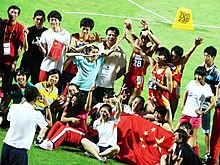
Back Deporte base Spanish Categorias de base Portuguese Ungdomsidrott Swedish Thể thao thanh niên Vietnamese

Youth sports is any sports event where competitors are younger than adult age, whether children or adolescents. Youth sports includes school sports at primary and secondary level, as well as sports played outside the education system, whether informally or organized.
In sports studies and public policy contexts, an age limit of 18 (the age of majority) is usual in discussing "youth sport". Not all sports governing bodies define "youth" as "under-18": while the Youth Olympic Games and the FA Youth Cup are for under-18s, the LEN Junior Water Polo European Championship is for under-17s. Many youth sport programmes have multiple age levels, for example under-8, under-10, under-12, etc. It is not, however, only underage sport that may be considered as "youth" sport; for example, the existence of the World Rowing U23 Championships recognises that adults aged 18–22 have not yet reached peak condition. Moreover, many definitions consider postsecondary/collegiate students ranging from the ages of 17 to 25 participating in sports to be "youth" as well.
Sport is one of the most popular activities among youth all over the world.[1] The most popular sports are association football, basketball, running and swimming.[citation needed] In 2008, a United Nations-sponsored report on "Sport for Development and Peace" stated:[2]
- Sport can contribute significantly to international, national and local efforts to give children a healthy start. Sport can help those who haven't received a good start, and equip youth with the information, skills, personal and social resources, and support needed to make key life transitions successfully.
According to WinterGreen Research, the size of the U.S. youth sports market has grown 55 percent since 2010 and is a $15.3 billion market in 2017.[3]
- ^ Cote, Jay; Hay, J (2002). "Children's Involvement in Sport: A developmental perspective". Psychological Foundations of Sport: 484–502.
- ^ Sport for Development and Peace International Working Group (2008). "Chapter 3: Sport for children and youth: fostering development and strengthening education; 1.2 Sport as a tool to promote child and youth development" (PDF). Harnessing the Power of Sport for Development and Peace: Recommendations to Government. Toronto: Right to Play. p. 81.
- ^ Gregory, Sean (2017-08-24). "How Kids' Sports Became a $15 Billion Industry". Time. Retrieved 2017-08-25.